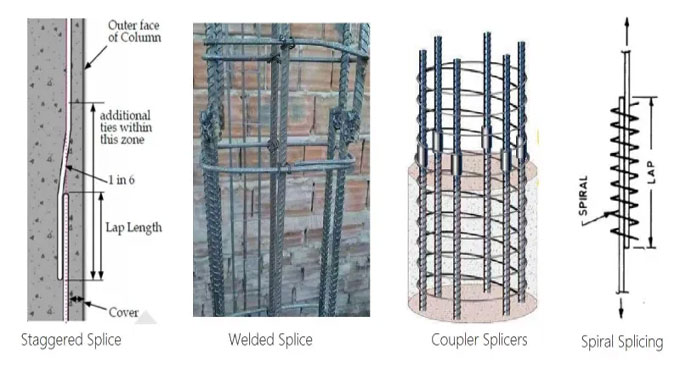
How To Splice Column Reinforcement As Per Indian Standard

In lap length or overlapping length two bars of a column are spliced for maintaining the continuity of the bars throughout the column. The overlapping process of two reinforcement bars is called lap splicing. This process provides the secure transfer of loads from one member to another.
The maximum length of reinforcement bars is 12 m. when reinforcement for a structure is greater than 12 m, more than two reinforcement bars are joined for achieving the required length. Lapping or splicing process is used while the connection is performed.
Lapping zone of columns as per indian standard
As per Indian standard the columns are separated into three parts. The parts are created by considering the moment diagram of the column under lateral load. The column is designed to a maximum moment at the ends and zero moment at the center. The top and bottom portion of the column is designed to maximum moment and is categorized as Zone-A. the portion where the moment reduces to zero is named as Zone-B. Then the less critical section of the column, Zone-B, creates the lapping zone of the column.
If the clear distance of the column is hc, then Zone-A has a length of hc/4. Then the height of Zone-B is given by (hc? (h/4 + hc/4)) = hc/2.
Lap splices for columns
1. The bars which are greater than 36mm, lapping are not used there. For larger bars connections are made using welding, couplers and welding with helical reinforcement.
2. Lapping is not given on the tension zones.
3. The general lap length of column reinforcement is the greater of development length Ld and 30d, where the ?d? is the diameter of the reinforcement bar. This value is considered only when the structural designer does not provide a lap length value.
4. The lateral reinforcement is provided in the lap length region. A closely spaced reinforcement is also provided at a distance lo from the top and bottom of the column. As per Indian Standard 13920-1993, clause.7.4.1, ?lo? is hc/6 or 450 mm
5. When bars of two different diameters are lapped then the lap length is calculated for the bar with smaller diameter.
6. The lapping should not be performed at column beam junction in the maximum wider area.
7. The lapping should be provided alternatively.
8. The rebars are lapped correctly to maintain the clear cover of the column.
9. The lapping length should not be less than 75 mm.
The offset splices the reinforcement bars in order to maintain the cover of the column throughout its depth. This bending of bars is called joggle. The crank length is the bend and it provides reinforcement for maintaining the clear cover. A maximum crank slope of 1:10 and a minimum length of crank of 300 mm is provided.
Crank length = (d1+d2+5)*10 mm
d1 is the diameter of the smaller bar and d2 is the diameter of the longest bar.
Crack length for reinforcement
The crank length is the bend which provides the reinforcement for maintaining the clear cover of the concrete structure. Mainly a maximum slope of 1:10 and a minimum length of crank of 300 mm is provided here.
The formula is Crack length = (d1 + d2 + 5) x 10 mm
Where d1 and d2 are the diameters of smaller and larger rebar which is used to lap.
Wrap up
If readers like this article please share your valuable feedback with us. Readers can write down their opinion in the comments section below the article.

Image Courtesy: theconstructor.org

